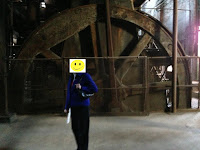Who has ever heard of Sloss Furnaces? I hadn't and I only live a couple of hours away from Birmingham. I first heard of them while I was watching an episode of
Ghost Hunters. The cast had gone to the furnaces to check out reports of paranormal activity there. When I realized the place was on the National Historic Landmark list, I had to go.

Sloss Furnaces was founded in 1881 and was once the WORLD's largest producer of pig iron. Pig iron? I didn't know either. It's a metal material created by the melting together under intense air pressure several materials. The name came from the processing technique: the hot liquid ore would run down a long tray that had several inlets. It was said this looked like a sow and her piglets.
 |
| Pig iron |
The furnaces began blasting in April of 1882 at the intersection of 2 major railroads. In its first year, it 24,000 tons of iron. Remember, this was the late 1800s. The site has 2 400-ton blast furnaces and forty other buildings. The oldest building dates from 1902 and the oldest machines date from around 1900. The massiveness (if that's a real word) is incredible. I climbed the steps to one of the machines and was amazed at the thought of working the site (as I held on tightly with both hands).

It is currently the only 20th century blast furnace in the US being preserved and interpreted as a historical industrial site.
And the ghost stories.....that's another story. Because of the deaths here and the manner in which they happened, many say there is paranormal activity here. My mom and I tried, but we didn't see or hear anything. You might have more luck.... You can take private tours, which are free, but they are only offered certain days and staff is limited so call first. You can always take a self-guided tour, which is also free.

You can definitely feel the history here.
For more information:
http://slossfurnaces.com/
















